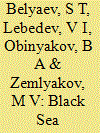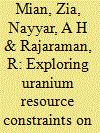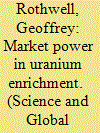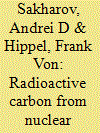|
|
|
Sort Order |
|
|
|
Items / Page
|
|
|
|
|
|
|
| Srl | Item |
| 1 |
ID:
092922


|
|
|
|
|
| Publication |
2009.
|
| Summary/Abstract |
The Soviet Navy used a helicopter/ship system called "Sovietnik" to detect a cruise-missile warhead in the joint USSR-US experiment on the Black Sea, Which took place on 5 July 1989.
|
|
|
|
|
|
|
|
|
|
|
|
|
|
|
|
| 2 |
ID:
092913


|
|
|
|
|
| Publication |
2009.
|
| Summary/Abstract |
This paper evaluates possible scenarios for Pakistan's uranium enrichment and plutonium production programs since the late 1970s by using Pakistan's supply of natural uranium as a constraint. Since international sanctions have prevented Pakistan from importing uranium for decades, it has had to rely on domestic uranium production-currently estimated as approximately 40 tons a year. The paper divides the development of Pakistan's uranium enrichment and plutonium production programs into three broad periods: from the beginning in the late 1970s until the 1998 nuclear tests; from 1999 to the present; and from the present to 2020; and considers how Pakistan could allocate its domestic uranium between its uranium enrichment and plutonium production programs for each period. This assessment is completed for enrichment capacities ranging from 15,000 to 75,000 separative work units (SWU) and takes into account the construction of the second and third plutonium production reactors at Khushab. The study finds that Pakistan may have sufficient natural uranium to fuel the three reactors, if they are approximately 50 MWt each, but that for some of these enrichment capacities, there will be a shortfall of natural uranium by 2020. The paper considers the impact of alternative sources of enrichment feed such as depleted tails from previous enrichment activity and reprocessed uranium from low-burn-up spent fuel from the Khushab reactors. There are signs Pakistan early on may have enriched some reprocessed uranium, possibly acquired from China. It finds that by 2020, Pakistan could have accumulated approximately 450 kg of plutonium from the Khushab reactors and 2500-6000 kg of highly enriched uranium (HEU) (90 percent enriched) for enrichment capacities ranging from 15,000-75,000 SWU. These stocks would be sufficient for perhaps 100-240 simple fission weapons based on HEU and for 90 plutonium weapons. Pakistan may be able to produce more weapons if it either increases its rate of uranium mining or has more advanced weapon designs requiring less fissile material in each weapon.
|
|
|
|
|
|
|
|
|
|
|
|
|
|
|
|
| 3 |
ID:
092920


|
|
|
|
|
| Publication |
2009.
|
| Summary/Abstract |
The following discussion focuses on the question of whether a terrorist organization or a threshold state could make use of plutonium recovered from light-water-reactor fuel to construct a nuclear explosive device having a significantly damaging yield. Questions persist in some nonproliferation policy circles as to whether a bomb could be made from reactor-grade plutonium of high burn-up, and if so, whether the task would be too difficult for a threshold state or terrorist group to consider. Although the information relevant to these questions is in the public domain, and has been for a considerable time, it is assembled here for use by policy makers and members of the public who are concerned about preventing the spread of nuclear explosives.
|
|
|
|
|
|
|
|
|
|
|
|
|
|
|
|
| 4 |
ID:
092914


|
|
|
|
|
| Publication |
2009.
|
| Summary/Abstract |
This article chronicles the rise and fall of fast-reactor research in the United States. Research on fast reactors began at the end of World War II and represented a large fraction of the total U.S. research effort on civilian nuclear energy until the early 1980s. The goal of most of this research was to develop a plutonium breeder reactor capable of producing more plutonium from U-238 than is consumed. But with the termination of the Clinch River Breeder Reactor project in 1983, fast reactor development in the United States essentially ended. Safety issues played a role in this end to the fast breeder reactor program, but more important reasons were nuclear proliferation concerns and a growing conviction that breeder reactors would not be needed or economically competitive with light water reactors for decades, if ever.
|
|
|
|
|
|
|
|
|
|
|
|
|
|
|
|
| 5 |
ID:
092916


|
|
|
|
|
| Publication |
2009.
|
| Summary/Abstract |
Four firms dominate the international uranium enrichment market. Simultaneously, the nations that host enrichment facilities strongly discourage other nations from developing enrichment capacity, given its potential use in nuclear weapons production. Therefore, these four firms benefit from the exercise of national power to prevent entry into this market. This paper shows that these firms also benefit from increasing returns to scale. In similar national situations, this industry would be regulated or nationalized. This is because free markets do not necessarily lead to a socially optimal long-run equilibrium where the industry is necessarily concentrated, such that there is no proliferating entry, but is sufficiently diverse, so that no one national group can dictate prices, contract terms, or non-proliferation policy. Therefore, some form of international regulation might be necessary to discourage enrichment technology proliferation and assure enrichment supply at reasonable prices.
|
|
|
|
|
|
|
|
|
|
|
|
|
|
|
|
| 6 |
ID:
092918


|
|
|
|
|
| Publication |
2009.
|
| Summary/Abstract |
In this article, which appeared in the June 1958 issue of the Soviet journal, Atomic Energy, Sakharov estimated that about 10,000 people would ultimately suffer cancers, genetic disorders, and other ill effects from the radioactivity produced by a 1-megation nuclear explosion in the atmosphere.
|
|
|
|
|
|
|
|
|
|
|
|
|
|
|
|
|
|
|
|
|